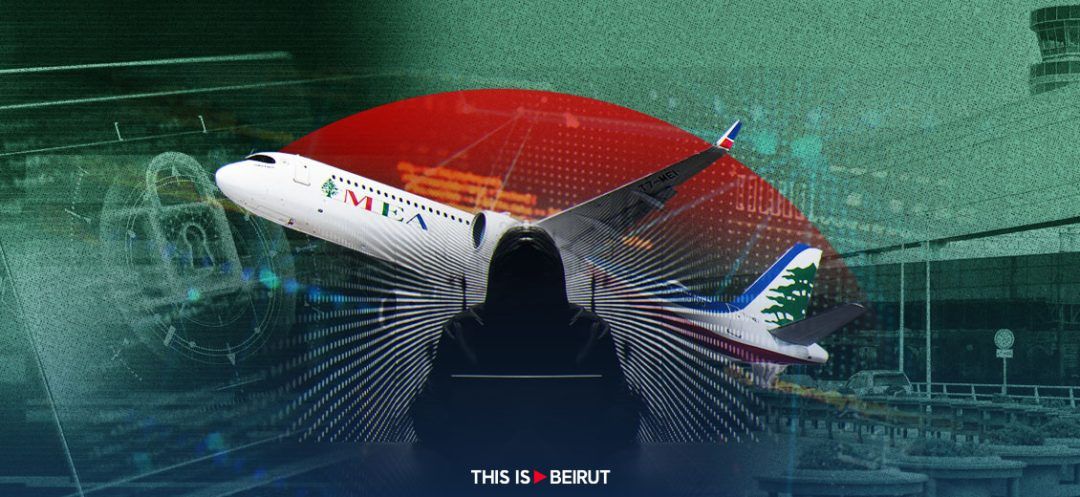- Home
- War in the Middle East
- When Electronic Warfare Threatens Civil Aviation

Since the beginning of the war in Gaza on October 7, 2023, the navigation systems at Beirut International Airport (BIA) have been experiencing near-daily disruptions, compromising the safety of civil aviation and causing the interruptions of some flights. What is the source of these disruptions, and what are BIA’s options?
According to global statistics, airplanes are regarded as the safest means of transportation. However, as the war rages on in Gaza, taking a flight from Beirut International Airport (BIA) has become a risky business.
In fact, since the outbreak of the war between Hamas and Israel on October 7, 2023, followed by the opening of the front in South Lebanon by Hezbollah the following day, airspace has been threatened by the disruption of navigation system signals.
This situation risks the safety of civil aviation. As recently as the end of March, a Turkish Airlines plane had to turn back as the pilot was unable to land at BIA due to signal interference with the Global Positioning System (GPS).
How do these disruptions work and for what purpose, especially considering that these occurrences also affect navigation systems in Israeli territory?
An Electronic Warfare
Electronic warfare often involves jamming enemy communications and navigation systems, usually to interfere with drones and missiles that use GPS to locate their targets.
GPS systems allow drones to navigate using signals transmitted by satellites. As they near the ground, the signal weakens, making it easier to jam.
Roland Abi Najem, a consultant in cybersecurity and digital transformation, explained to This is Beirut that there are two types of interference with GPS signals: jamming and "spoofing."
Jamming, as the name suggests, disrupts the signal transmitted by the satellite. The result is that the receiver simultaneously collects different geolocations. This loss of precision is directly detectable by the user.
Spoofing, on the other hand, is the intentional transmission of fake GPS signals, resulting in false position or time data. The goal is to deceive the user by diverting them from their actual position. This occurrence is more difficult to detect than jamming.
In the context of ongoing conflicts, beginning with Gaza and Southern Lebanon, all the way to the strikes affecting several countries in the Middle East region, Israel is using jamming to disrupt drones and GPS-guided missiles targeted towards its territories.
Consequently, disruptions of GPS signals have been recurrent at BIA since last October. In response to questions raised by This is Beirut, the Civil Aviation Directorate did not provide any answers.
Insert image GPSJam
Since the beginning of the Gaza war, Israel has been using jamming and "spoofing" in the north of the country, near the border with Lebanon. However, due to recent regional developments, it has recently expanded this technique countrywide. Therefore, the defense system is turning against its users, as Israelis are impacted as well.
Between Technology and Politics
GPS systems are among many others in a global set of satellite navigation systems known as the Global Navigation Satellite System (GNSS). They are developed by the United States, Israel's first ally.
Insert Image GNSS
In this context, Roland Abi Najem raises a crucial point, "No one can use technology created by the enemy and expect to have total control over it."
"In other words, if Hamas and Hezbollah use GPS systems developed and managed by the United States, they should not be surprised at being outdone and bypassed by increasingly advanced Israeli technologies, especially through artificial intelligence," Abi Najem asserts.
Even before Hamas' attack on Israel on October 7, an Israeli company had already developed new anti-jamming technology designed to protect Israeli army drones from any disruption.
This highlights that technological improvement projects are still ongoing, whether there is an ongoing war or not. If Hamas resorts to signal jammers to disrupt Israeli mini-drones, they will realize that these drones are already immune.
BIA’s Options
Such events are extremely dangerous, especially to airport traffic. They raise significant questions about security and defense measures against such threats.
Protection solutions against jamming and "spoofing" attacks exist. However, needless to say that the cost of these technologies is enormous and, as such, unaffordable to the Lebanese state.
In the absence of anti-jamming techniques, BIA's only option is to rely on conventional ground-based navigation systems. The radar used by air traffic controllers does not rely on satellites.
Therefore, for civilian pilots landing at BIA, it becomes essential to use alternative location methods, namely ground towers.
"Pilots are currently routinely using GPS and may not be familiar with conventional procedures," Abi Najem points out. "It is a major responsibility for the pilot to avoid taking risks at this level."
The latest example is that of the German airline Lufthansa, which has just extended the suspension of its flights to and from Beirut until the end of April.
Official Initiatives
On March 22, the Ministry of Foreign Affairs instructed Lebanon's permanent mission to the United Nations in New York to "urgently file a complaint with the UN Security Council regarding Israel's disruption of navigation systems and the safety of civil aviation in BIA's airspace since the beginning of the Gaza war," per a statement.
This action was taken based on the proposal of the Ministry of Public Works and at the request of the Council of Ministers.
Meanwhile, on March 5, the caretaker Minister of Public Works, Ali Hamiye, urged the European Union (EU) to "take drastic measures to put an end to the serious threat to air safety in the whole region" due to Israel's interference with navigation systems.
These initiatives, like many others, have been overlooked. Until further notice, Lebanon is trapped in a complex situation, with converging technological advancements, military aims and political interests.

Comments